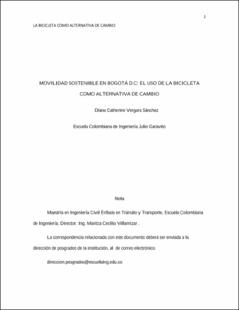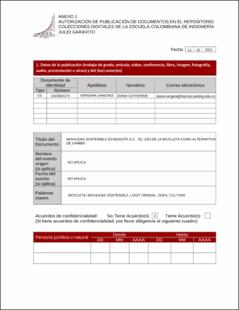Mostrar el registro sencillo del ítem
MOVILIDAD SOSTENIBLE EN BOGOTÁ D.C: EL USO DE LA BICICLETA COMO ALTERNATIVA DE CAMBIO
| dc.contributor.advisor | Villamizar, Maritza Cecilia (dir) | |
| dc.contributor.author | Vergara Sanchez, Diana Catherine | |
| dc.date.accessioned | 2021-11-03T05:25:58Z | |
| dc.date.available | 2021-11-03T05:25:58Z | |
| dc.date.issued | 2021 | |
| dc.identifier.uri | https://repositorio.escuelaing.edu.co/handle/001/1795 | |
| dc.description.abstract | Existen innumerables factores que influyen en el uso o no de la bicicleta como medio de transporte, entre ellos los aptitudinales característicos de cada persona y su percepción de seguridad, movilidad, comodidad, y “calidad” de vida. Es pertinente aclarar, que todo cambio es un proceso, es por ello que el modificar la forma de moverse también lo es; por ello hace ya varios años se han desarrollado ajustes en la ciudad en materia de infraestructura, intermodalidad, seguridad, programas y pedagogías para motivar la variación en la forma de moverse en el ciudad de Bogotá D.C. En la búsqueda de una movilidad sostenible en la ciudad de Bogotá D.C. la bicicleta se convierte en protagonista, es por ello que la presente investigación pretende conocer los factores que influyen en el uso de la bicicleta como medio de transporte, partiendo de los que son directamente observables y continuando con las percepciones y/o actitudes que los ciudadanos tienen respecto a este modo de transporte. Partiendo por la compilación de información secundaria en conceptos de movilidad sostenible; la normatividad que reglamenta la promoción y uso de la bicicleta como medio de transporte y los programas para fomentar la bicicleta tanto nacionales como e internacionales, se abordan los factores que pueden influir en el uso de este modo de transporte. Se identifican aspectos clave relacionados al comportamiento, cultura e infraestructura dentro del uso de la bicicleta, presentado mediante estadística descriptiva estrategia DOFA y cartográfica la información obtenida con encuestas a los bici usuarios en la ciudad de Bogotá. Posteriormente, haciendo uso de modelos Logit Ordinal para el análisis de los datos conseguidos por medio de encuestas a ciudadanos de Bogotá, se reconocen varios de los factores personales y del entorno construido que influyen en el uso de la bicicleta, factores que al ser variables latentes (no observables) deben ser estudiadas mediante modelos econométricos, para abordar desde este análisis las conclusiones y recomendaciones que el estudio en su conjunto evidencia respecto de los factores más relevantes. | spa |
| dc.description.abstract | There are innumerable factors that influence the use or not of the bicycle as a means of transport, among them the characteristic aptitude of each person and their perception of safety, mobility, comfort, and "quality" of life. It is pertinent to clarify that all change is a process, that is why modifying the way of moving is also a process; For this reason, for several years the city of Bogotá has been implementing adjustments in terms of infrastructure, intermodality, security, programs, and pedagogies to motivate the variation in the way of moving in the city. In this quest for sustainable mobility in the city of Bogotá D.C. The bicycle becomes the protagonist, that is why this research aims to know the factors that influence the use of the bicycle as a means of transport, starting from those that are directly observable and continuing with the perceptions and/or attitudes that citizens have respect to this mode of transport. Starting with the compilation of secondary information on sustainable mobility concepts; The regulations governing the promotion and use of bicycles as a means of transport and programs to promote bicycles, both nationally and internationally, address the factors that may influence the use of this mode of transport. Key aspects related to behavior, culture, and infrastructure within the use of the bicycle are identified, presented through descriptive statistics, SWOT strategy, and cartographic information obtained from surveys of bicycle users in the city of Bogotá. Subsequently, making use of Ordinal Logit models for the analysis of the data obtained through surveys of citizens of Bogotá, several of the personal factors and the built environment that influence the use of the bicycle are recognized, factors that being latent variables (unobservable) should be studied using econometric models, to address from this analysis the conclusions and recommendations that the study as a whole shows as the most relevant factors | eng |
| dc.format.mimetype | application/pdf | spa |
| dc.language.iso | spa | spa |
| dc.publisher | Escuela Colombiana de Ingeniería Julio Garavito | spa |
| dc.title | MOVILIDAD SOSTENIBLE EN BOGOTÁ D.C: EL USO DE LA BICICLETA COMO ALTERNATIVA DE CAMBIO | spa |
| dc.type | Trabajo de grado - Maestría | spa |
| dc.type.version | info:eu-repo/semantics/acceptedVersion | spa |
| oaire.accessrights | http://purl.org/coar/access_right/c_14cb | spa |
| oaire.version | http://purl.org/coar/version/c_ab4af688f83e57aa | spa |
| dc.description.degreelevel | Maestría | spa |
| dc.description.degreename | Magíster en Ingeniería Civil | spa |
| dc.publisher.faculty | Ingeniería Civil | spa |
| dc.publisher.program | Maestría en Ingeniería Civil | spa |
| dc.rights.accessrights | info:eu-repo/semantics/closedAccess | spa |
| dc.subject.armarc | Bicycle, Ordinal Logit Model, SWOT strategies, Georeferencing | |
| dc.subject.armarc | Bicicleta, Modelo Logit Ordinal, estrategias DOFA, Georreferenciación | |
| dc.type.coar | http://purl.org/coar/resource_type/c_bdcc | spa |
| dc.type.content | Model | spa |
| dc.type.driver | info:eu-repo/semantics/masterThesis | spa |
| dc.type.redcol | https://purl.org/redcol/resource_type/TM | spa |
Ficheros en el ítem
Este ítem aparece en la(s) siguiente(s) colección(ones)
-
CA - Trabajos Dirigidos de Civil [85]
Trabajos del Pregrado de Ingeniería Civil de la Escuela Colombiana de Ingeniería Julio Garavito











